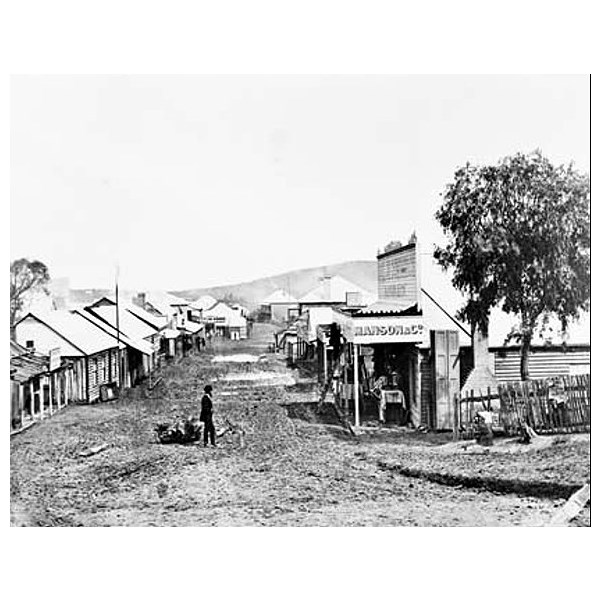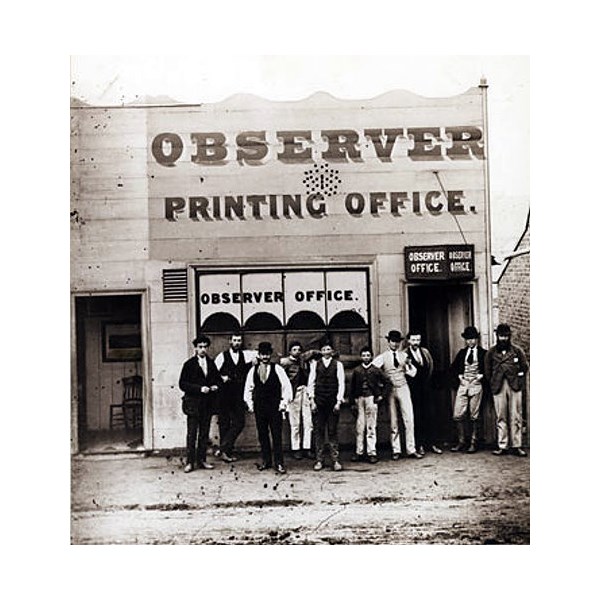Hill End was among the greatest of Australian goldfields and in its heyday more than 200 companies worked fabulously rich reefs. At the time of the gold discovery in 1851
Hill End was known as '
Bald Hill' and named '
Hill End' in 1862.
In 1872 what was, at the time, the world's largest specimen of reef gold - the 'Holtermann's Nugget', weighing 285 kg and measured 150 cm by 66 cm with an average thickness of 10 cm.

Holtermann's Nugget, unearthed in 1872

Holtermans Arcade Shops,

Clarke Street in Hill End 1872
After this the town grew to over 8000 people, making it one of NSW's largest inland towns with a kilometer plus of shops, five banks, two newspapers, a brewery, 27 hotels - all doing
well - now the
Royal Hotel (1872) is the only one remaining.
There was a mile of shops, The air was filled with the clatter of Stamper Batteries, People slept on Pub verandahs and Bar room floors as the town’s accommodation facilities were strained to keep up with the influx of miners, merchants, and adventurers.
Clarke St and Tambaroora Rd were the focus for all the activity, Fortunately a Photographer named Beaufoy Merlin recorded the streets with great detail during the boom days of 1872.
The Northern end of Clarke St was the place be, Land sold for around Ten Pounds per footand weekly rentals went as high a Shilling a foot, At that rate Smith’s Cheapjack Tobacco and Fancy Goods store would have been up for 8 Shillings a week , the
shop was the smallest store in town .

Smiths Cheapjack Tobacco and Fancy Goods store

Condell's Great Western Boot Mart

Hill End Observer Printing Office
Every Sunday the Bells of
Hill End Churches would ring out calling the faithful to Worship, it’s a wonder anyone heard them above the din made by the Stamper batteries operating around the town.
Bt 1873 the town boasted four splendid churches as a result of the generosity of successful miners and the energetic efforts of local fund raising committees.

St Paul's Presbyterian Church

St Paul's Presbyterian Church today
Wild sprees and decadent binges were out as far as
Hill End was concerned, Everyone had to conform to the community’s strict Victorian attitudes and standards.
Anyone indulging in drunk and disorderly behaviour was liable to be arrested whilst confidence men, crooks and prostitutes rarely got time to unpack their baggage before the police moved them on their way.
Today
Hill End is an important historic site being a
well-preserved goldmining ghost town. Most local buildings are managed by the National Parks & Wildlife Service as a ‘Historic Site’ of national significance.
275km from
Sydney and 870m above sea-level you can travel to
Hill End via
Bathurst. From
Bathurst either travel through
Sofala, Turondale or follow the scenic route which follows the Macquarie and Turon Rivers called The
Bridle Track.
Hill End is classified as a Historical site by the National Parks and Wildlife Service (NPWS), however it is still
home to a handful of residents operating the local pub,
general store, cake store and antique store. The National Parks and Wildlife Service runs a museum just off the main road which contains many original photos and items of equipment from the busy days of the gold rush.
NPWS has installed signs around the town to give visitors an idea of what was once in place on the now empty lots of land. Currently only a handful of buildings remain in their original form. However most of those buildings still serve the purpose they did back during the gold rush. Access to the town's lookouts is via gravel roads. A walking track in the town leads to a
mine and other
ruins.
Hill End remains as an excellent 4WD destination. The most exciting of these is the
Bridle Track which runs from
Duramana (North of
Bathurst) directly to the town centre of
Hill End. Generally the track can be classified as an easy track, however extreme care must be taken as the road surface has been known to change during the different seasons and after heavy rain during which it can become challenging for the unwary.

Entrance sign to the Bridle Track that runs between Hill End and Bathurst NSW
The
Bridle Track begins as a narrow tar-covered road, however it later changes to dirt. Much of the last 20 km is single-lane, and will not allow any overtaking which makes things awkward to come across on-coming traffic. It is also strongly suggested not to attempt to travel along the track after nightfall or after heavy rain, as the track does skirt around some very large drops. Ideally a vehicle should be fitted with Low Range to complete this track.
Note: I was blown away by the amount of history preserved in this town, and what really topped off the Sunday morning visit was a group of 4 aged locals out front of the hotel armed with 2 guitars and beers singing Slim Dusty songs, I might add the old fella was damn good too.